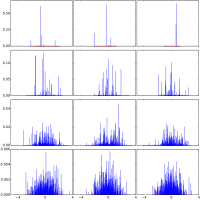Dirichlet process

Let's imagine a big box of different colored balls. The Dirichlet process is like taking a handful of balls out of this box, but instead of just grabbing a set number of balls, we keep grabbing balls until we've grabbed every color at least once.
Here's how it works: Imagine you want to group things together based on certain shared characteristics (like grouping people based on their hobbies or food preferences). The Dirichlet process helps you do that by assigning these groups randomly, but in a way that makes some groups more likely to form than others.
To be more specific, the Dirichlet process starts by assigning one item to a group. Then, for each additional item, it randomly assigns it to either a new group with some probability or to an existing group with some other probability. But here's the catch - the probability of assigning a new item to a new group depends on how many groups already exist. So if there are fewer groups, new items are more likely to form a new group.
This process keeps going until every item is assigned to a group, ensuring that every group has at least one item. And just like our handful of balls, some groups will have more items than others, depending on how many times they were chosen throughout the process.
The Dirichlet process is often used in statistics to model things like clustering or density estimation, but at its core, it's just a way of randomly grouping things together - like finding all the red balls in our box and putting them in one group, then all the blue balls in another group, and so on, until we've used up every color.
Here's how it works: Imagine you want to group things together based on certain shared characteristics (like grouping people based on their hobbies or food preferences). The Dirichlet process helps you do that by assigning these groups randomly, but in a way that makes some groups more likely to form than others.
To be more specific, the Dirichlet process starts by assigning one item to a group. Then, for each additional item, it randomly assigns it to either a new group with some probability or to an existing group with some other probability. But here's the catch - the probability of assigning a new item to a new group depends on how many groups already exist. So if there are fewer groups, new items are more likely to form a new group.
This process keeps going until every item is assigned to a group, ensuring that every group has at least one item. And just like our handful of balls, some groups will have more items than others, depending on how many times they were chosen throughout the process.
The Dirichlet process is often used in statistics to model things like clustering or density estimation, but at its core, it's just a way of randomly grouping things together - like finding all the red balls in our box and putting them in one group, then all the blue balls in another group, and so on, until we've used up every color.
